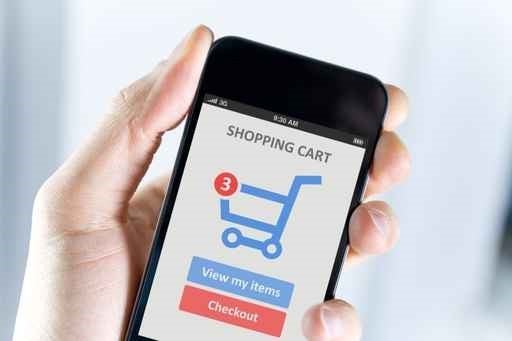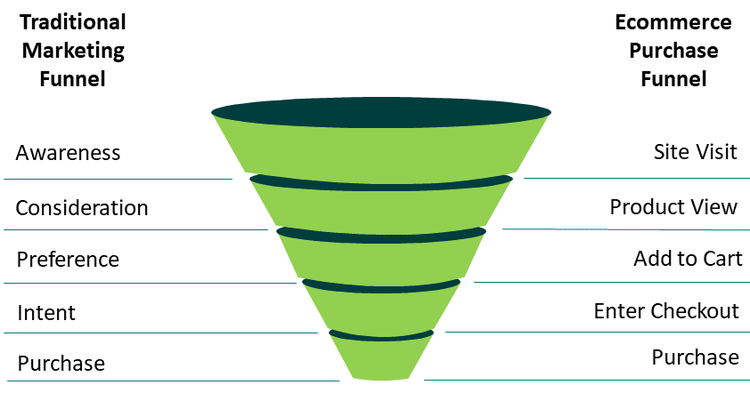If your business sells products or services online, you’ve got a conversion funnel. Your marketing efforts serve to drive people to and through this funnel. As such, the funnel maps to your customer life cycle, with each stage of the funnel providing indicators for how to close a sale and turn site visitors into customers.

Successful online stores take advantage of the conversion funnel to boost sales. Image source: Author
Successful marketing teams monitor their website funnel to make informed decisions for optimizing customer acquisition and moving leads along in the sales pipeline. Funnel optimization is a critical marketing objective that positively impacts business metrics such as customer prospecting rates and cost per acquisition.
Read on to learn what exactly your website marketing funnel is and see some marketing funnel conversion best practices. You’ll find tips for digital marketing teams to conduct website funnel analysis to ensure marketing campaigns are providing the most return on investment.
Overview: What is a conversion funnel?
A conversion funnel is a group of consecutive stages articulating the path website visitors take as they become customers. It’s a visual construct that gives marketers another layer of customer segmentation to make outreach more targeted.
The goal is use the right mix of marketing channels to drive site visitors through the funnel and get them to convert.

Your site’s purchase funnel maps directly to your traditional marketing funnel. Image source: Author
Converting means different things depending on the nature of your business. If you’re using e-commerce platforms to host and sell products online, then your funnel ends when your site visitor makes a purchase and becomes a customer.
This is the context we’ll use for the remainder of the article, but it’s important to note other ways the conversion funnel can operate.
There is a different end of the funnel for business-to-business (B2B) companies and businesses with more complex purchase orders. The funnel for these types of businesses might simply end when a visitor converts, providing valuable information and becoming a highly qualified lead (HQL) that sales will reach out to directly.
This isn’t always the case though, as some organizations are set up so that an HQL remains in the marketing funnel until they seek to make a purchase. Only when they inquire about purchasing will an HQL be assigned a sales member to close the deal.
What are the parts to the conversion funnel?
The funnel stages remain constant regardless of your type of business. Your marketing teams can work with these stages to manage email lists and send highly targeted e-commerce email marketing messaging based on funnel stage.
You can also optimize your content management system to operate similarly by tagging content based on funnel stage so that content recommendations help drive visitors down the funnel.

Successful online businesses work to boost not just visitor numbers but also visitor quality so that more visitors are more likely to make a purchase. Image source: Author
Here’s a breakdown of the five stages of the conversion funnel:
Awareness
Here a site visitor gains a general awareness of your brand, business, product, or website. They could land on your site through social media, organic search, PPC, or via content hosted on third-party sites.
This is the lead generation, mass marketing part of your marketing strategy. Marketing analytics plays a major role here in identifying valuable segments and personas that you can target to maximize the return on marketing efforts.
This is critical because although awareness is a numbers game, even the slightest targeting of those “numbers” will ensure you’re reaching the right shoppers.
Consideration
Here a site visitor shares a bit of their information to gain more information about your brand and products. They could be returning to your site after prior research, or they could be immediately continuing on after their initial awareness visit.
This is where you’ll start to build a relationship with the visitor. Now that they have provided contact information and shown interest in at least your brand, if not a specific product, you can target them with more direct marketing. This includes personalized email messages and offers, display ads, and more.
Preference
Here a site visitor is indicating a preference for a particular product on your site. They may still be on their initial awareness site visit. And in fact, they could have jumped straight to preference if they’re searching for particular products.
This is why it’s critical to optimize your product profiles so that they rank highly on organic search results.
This is where you’re really honing your outreach. You’ve got a bit of contact information, and you have an idea of which product they’re interested in. The same set of email and display ads apply here, but you should make them much more targeted and personalized to deepen the relationships and encourage a purchase.
This is a great time to highlight any positive product reviews that you may have.
Intent
Here a site visitor is indicating their intent to purchase a product. They’ve viewed products on your site multiple times and even added some products to their shopping cart or wish list if your site supports that.
This is where you provide that final push to get the consumer to take action and purchase from your site. Your marketing efforts here consist of highly targeted messaging that evokes purchasing behavior and positions your brand and products to exactly what the visitor needs.
Purchase
Here a site visitor is making a purchase and becoming a customer. It’s up to you to ensure they become your customer.
It’s critical here that your site provides a quick, seamless experience. Items in the cart, move to checkout, purchase, new customer. From a marketing perspective, you’re looking to close the deal here while maximizing returns.
You don’t want to push sales or discounts unless you absolutely have to. And you may even consider marketing some upsell messaging to visitors identified as highly valuable.
How to create your own conversion funnel
Your online store innately has a conversion funnel, but there’s still plenty of strategies to create. It’s up to your business to be intentional and proactive in building marketing strategies that successfully address consumers and move them down the funnel.
Here are a few steps you can take to optimize your marketing efforts and monitor their effectiveness across your conversion funnel.
Step 1: Measure for key business metrics
Your first step in optimizing your conversion funnel is to maximize visibility of funnel movements by putting attribution and monitoring mechanisms in place.
You need proper analytics and tracking tools to note who is visiting your site and where they came from beforehand. Only then can you qualify the marketing tactics that move the needle and quantify their individual impacts.
Tips for measuring key business metrics:
Here are a couple of tips for getting the proper mechanisms in place to gain visibility into your funnel.
- Google Marketing Platform: Google offers a range of attribution capabilities that provide site owners with detailed insights into site visitors. Most offerings are affordable if not free and almost all of them will integrate with your existing CRM software or e-commerce platform.
- Build a full picture: While your main goal is moving site visitors through your conversion funnel to make a purchase, there are tons of metrics you should consider. Be sure to measure key indicators like revenue per visitor, pages or products visited.
Step 2: Iterate your marketing tactics
Your marketing efforts must be aligned and designed to move site visitors down your conversion funnel. It’s critical that you’re constantly iterating and testing new marketing tactics and channels. Be intentional in your messaging and design communications to correspond to each stage of the funnel.
Tips for conversion marketing success:
Here are a couple of tips for iterating and finding successful marketing tactics that move the needle.
- Always A/B test: A/B testing is a proven tactic that you should be deploying across email, social, and display campaigns. Conduct tests on every campaign and then spend the time to absorb and implement the findings for future campaigns.
- Consistency is key: As site visitors move through your funnel, they’re building a relationship with your brand. It’s critical that you provide consistent brand messaging, both in tone and aesthetic, in all your marketing to protect and strengthen these relationships.
Step 3: Deliver personalized messaging throughout the funnel
Personalization has become table stakes for enterprise brand communications. And the tools are ever more available and affordable for your online business to automate and achieve personalization as well.
Tips for personalizing outreach throughout the conversion funnel:
Here are a couple of tips for delivering meaningful, highly personalized marketing messaging.
- Data collection: The foundation of marketing personalization is data collection. You must adopt, implement, and integrate systems like CRM and marketing automation to truly scale personalized messaging across your conversion funnel.
- Embrace emerging tech: As you research, you’ll quickly see that marketing personalization relies on artificial intelligence and machine learning. Lean into these paradigm shifting capabilities, do your homework, and push your vendor to help you best understand how to implement these mechanisms to deliver true personalization across your conversion funnel.
Use the conversion funnel to your advantage
There are innumerous strategies and channels and platforms and messaging for your marketing efforts to leverage. Before you consider any of them, it’s critical to establish marketing principles that root your efforts in your conversion funnel.
This is the foundation through which all the marketing tactics should be judged. If it appropriately addresses a specific stage of your funnel, then it may be a tactic you can use to turn site visitors into customers.
Our Small Business Expert
We're firm believers in the Golden Rule, which is why editorial opinions are ours alone and have not been previously reviewed, approved, or endorsed by included advertisers. The Ascent does not cover all offers on the market. Editorial content from The Ascent is separate from The Motley Fool editorial content and is created by a different analyst team.